The Jellyfish: An Extraordinary Creature |
According to scientists, a long, long time before dinosaurs ever shattered the earth with their giant steps, jellyfish were already drifting on gentle ocean currents, stinging their prey. These are perhaps the most enigmatic and alien looking marine animals in the world. They are the oldest multi-cell organism we know and have more than 2,000 different species. They can be found in any ocean, and at any depth. Some glow, some change colors and some even seem to be immortal. These weird creatures are ancient and beautiful, and can carry quite a poisonous punch. So let us examine what we know about jellyfish, while also seeing how beautiful and varied these creatures can be! |
 |
Jellyfish don't fight the flow of the ocean, they have been drifting on it for millions of years, and were already old even when dinosaurs roamed the planet. Few marine animals are as mysterious and alien as the jellyfish. This type of jellyfish, in the photo above, has tentacles that can reach up to 4.5 meters (15 feet) long. |
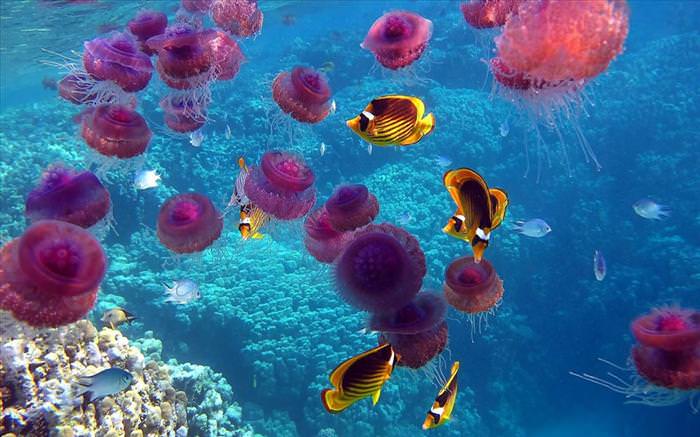 |
Inside what is known as the 'bell' or 'umbrella' shape of the jellyfish body is a mouth opening. Their tentacles have stinging cells that stun or paralyze their prey before they bring it up to the mouth to be eaten. While most jellyfish are content to float and drift on the ocean currents, they can squirt water from their mouths to propel them forward. |
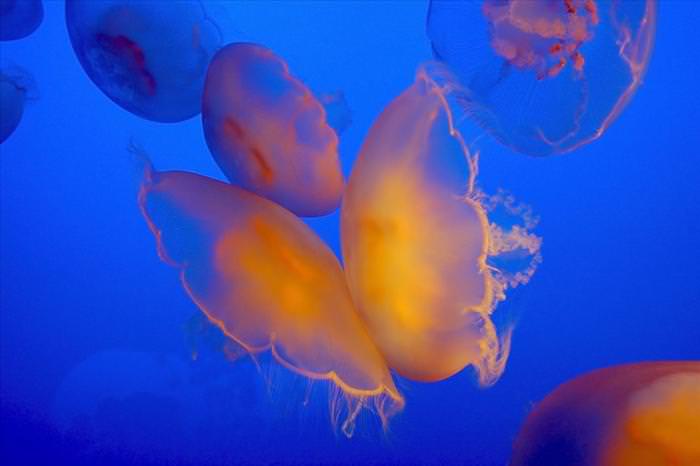 |
| Butterfly looking Jellyfish |
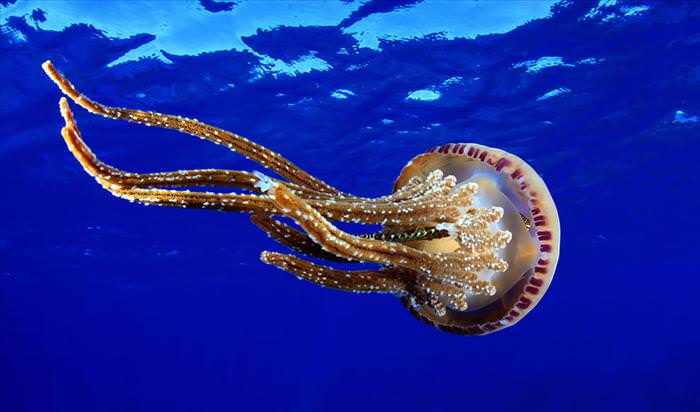 |
| We may not need to look far to see alien forms, perhaps just explore the depths of our oceans. A few years ago, a leading British space scientist claimed aliens do exist and that they look like big jellyfish! |
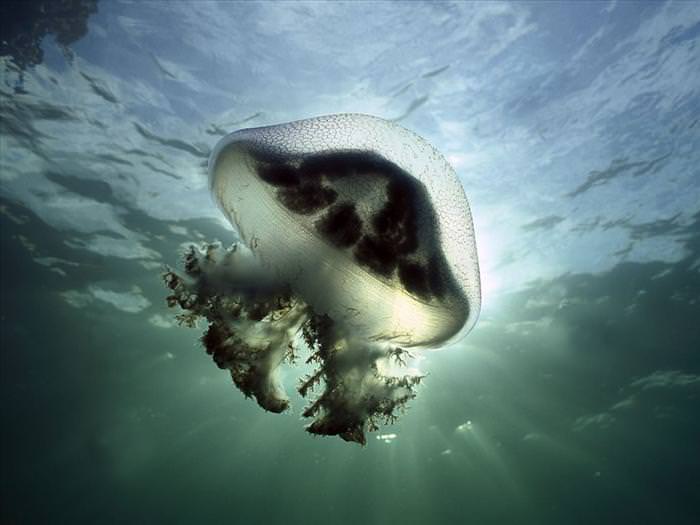 |
This is a "Mauve Stinger" in Australia, the second most feared jellyfish in Australian waters, after the dreaded 'box jellyfish'. |
 |
The amazing looking 'Medusa Cassiopea' lives primarily in the Mediterranean sea. |
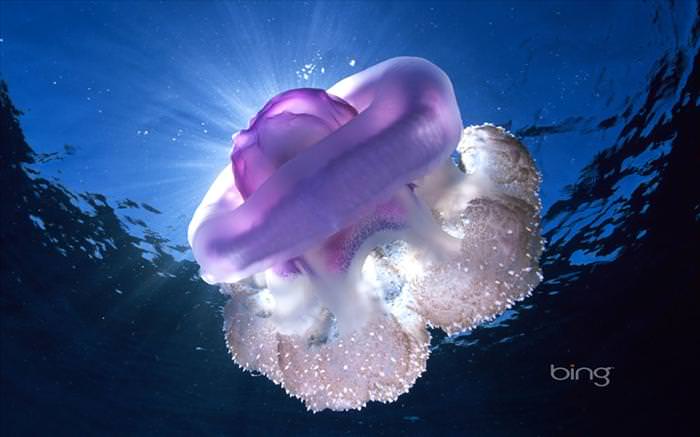 |
| This 'crown jellyfish' can be distinguished from others by the deep groove running around the bell shaped body, giving it a sort of crown shape which is the origin of the name. They are usually found in deep sea environments, but from time to time can be caught closer to the surface, like this one. |
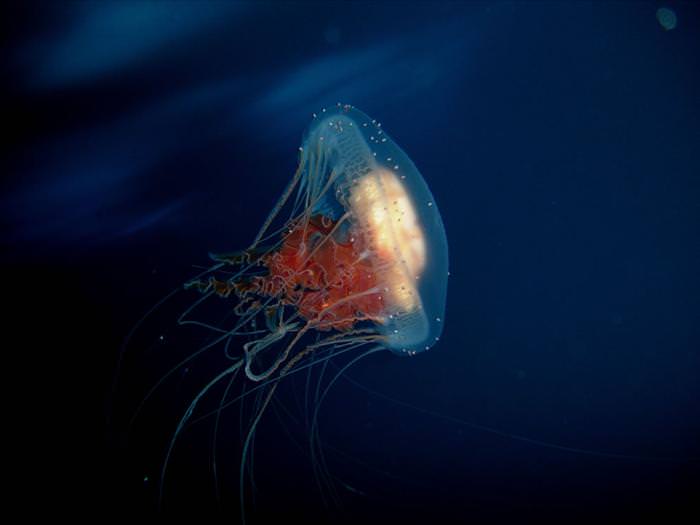 |
| Papuan Jellyfish (Mastigias Papua) in a special exhibit at the Monterrey Bay Aquarium. |
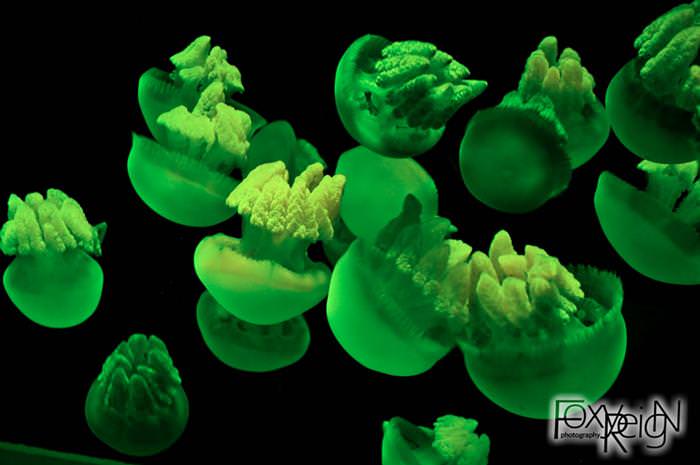 |
From Manila ocean park, a display of sea jellies. Evidence suggests that jellyfish are older than dinosaurs by as much as 400 million years! |
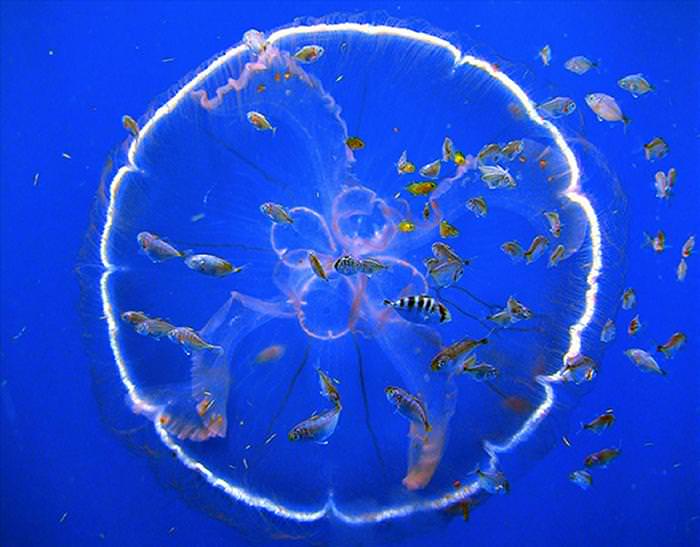 |
| This amazing photo is of a group of fish following a huge transparent jellyfish as it drifts on the currents. The type of jellyfish is known as 'Aurelia Aurita', and it has toxins in its tentacles. Jellyfish will sting anything that comes in contact with them, be they fish, mammal or human. |
 |
| Papuan Jellyfish (Mastigias Papua) in a special exhibit at the Monterrey Bay Aquarium. |
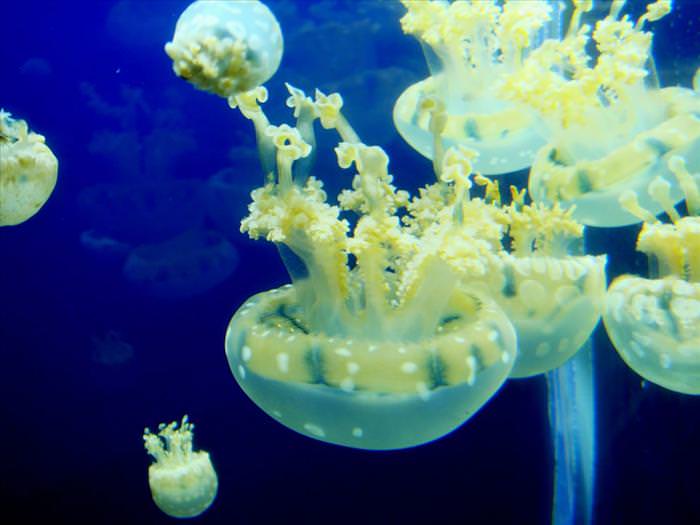 |
This jellyfish was discovered on a special mission by the National Oceans and Atmospheric Administration (NOAA) to the hidden depths of the sea canyons. |
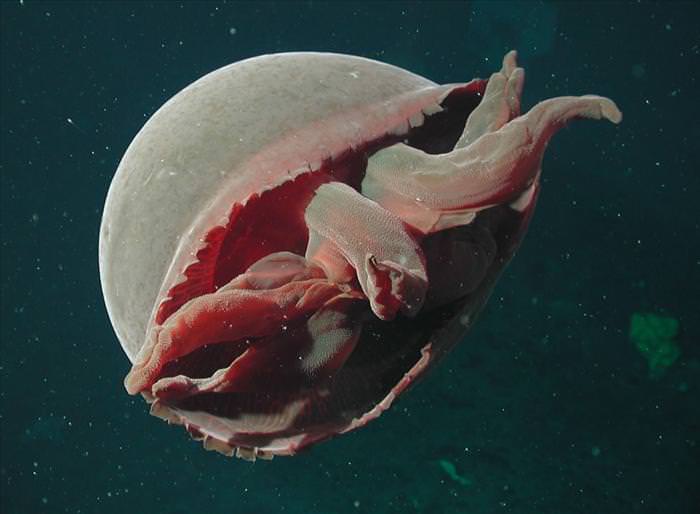 |
The 'Tiburonia granrojo' jellyfish was recently discovered. This jellyfish can get up to 1 meter (3.2 feet) in diameter. |
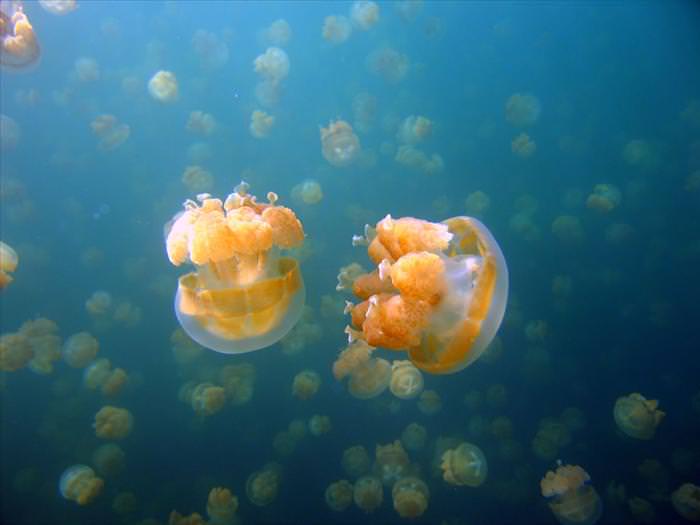 |
The 'Cassiopea' is also known as the 'upside-down' jellyfish. Their tentacles, while not high in toxins, cause a very annoying itch, that appears as a red rash on the skin. A group of jellies is called a 'swarm' or a 'Smack'. |
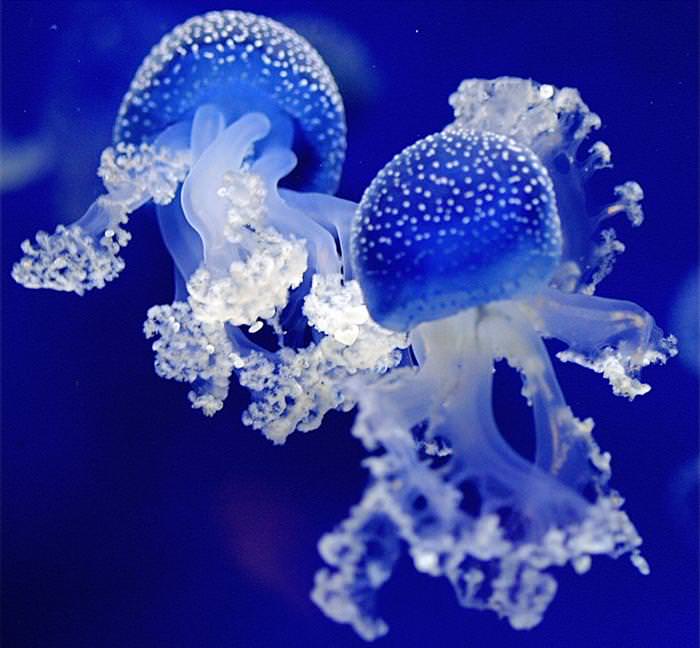 |
| Some types of jellies are actually fluorescent. These were shot in an aquarium in Holland. |
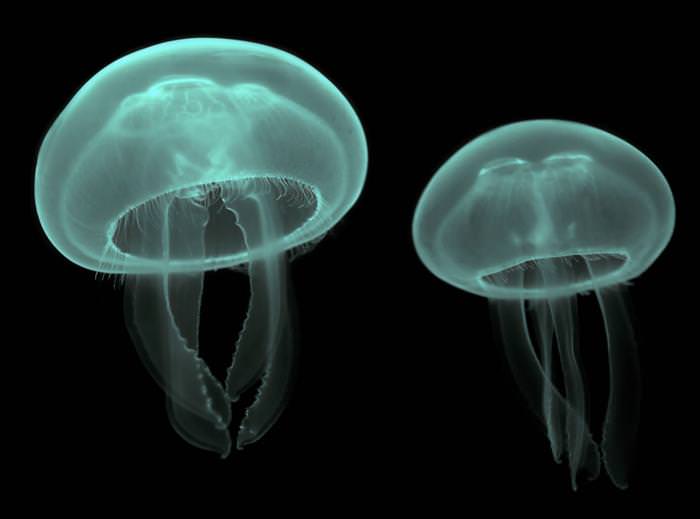 |
| These 'moon jellyfish' are some of the most common types of jellies found in aquariums around the world. They are slightly venomous and can cause itches and burning pain. |
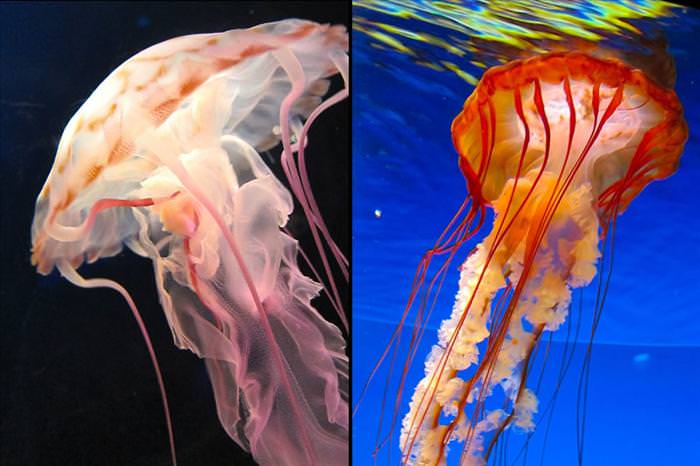 |
| Jellyfish at the Osaka Aquarium |
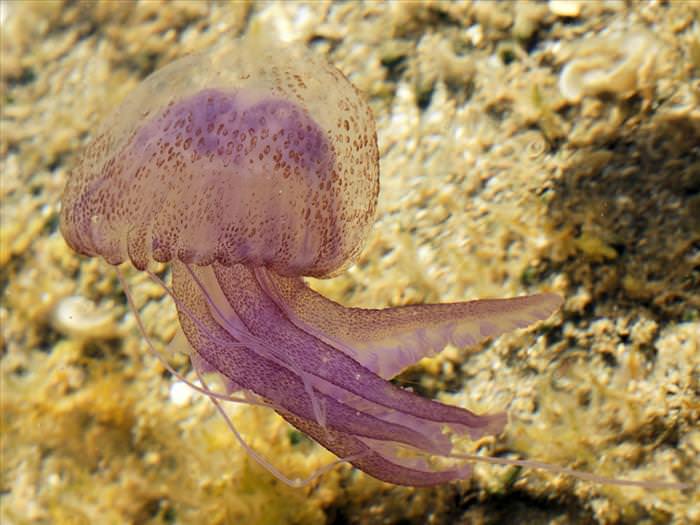 |
| This Mauve Stinger jellyfish was shot near the south coast of Sardinia, Italy. |
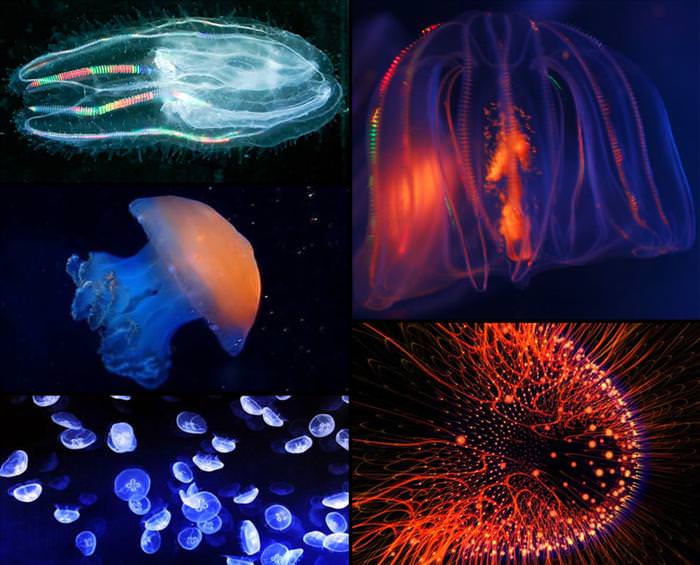 |
Marine biologists are still discovering new types of jellyfish that carry their own light (or, in other words, have 'bio-luminescence'). Many of them can glow and light up in myriad colors, sometimes as a warning to other creatures to 'stay away'. |
 |
| This jellyfish lights up in pale blue. |
 |
| A delicate looking jelly in white and pink. |
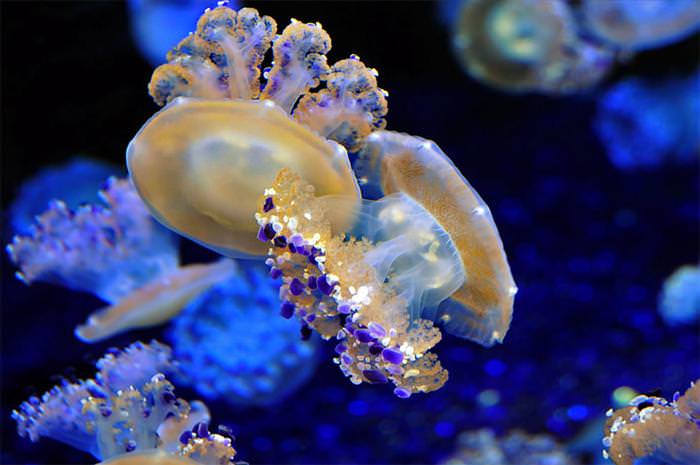 |
| This jelly is of the Cassiopeia Mediterranean species, and usually can reach about 30 cm (1 foot) in diameter. It has numerous short tentacles. |
 |
| Olindias Formosa at Osaka Aquarium. This jelly lives on small fish, and although its sting can be painful, it poses no actual risk to humans. |
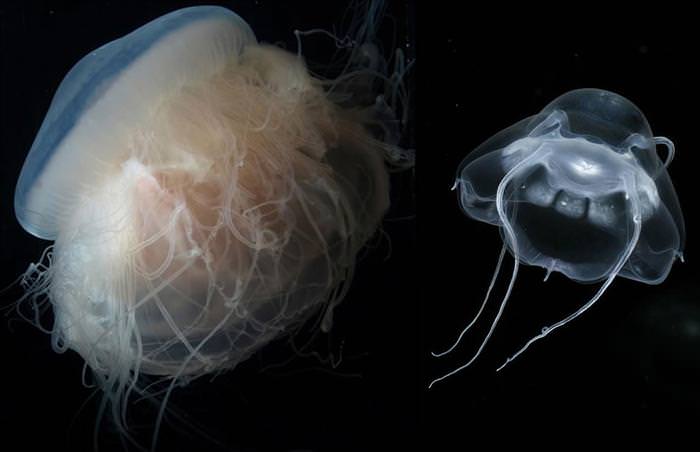 |
| The 'sea nettle' is a bit transparent and sometimes comes with stripes, sometimes not. It has a saucer like shape and arms attached to the underside of the mouth. It has long tentacles that can reach several feet in length. |
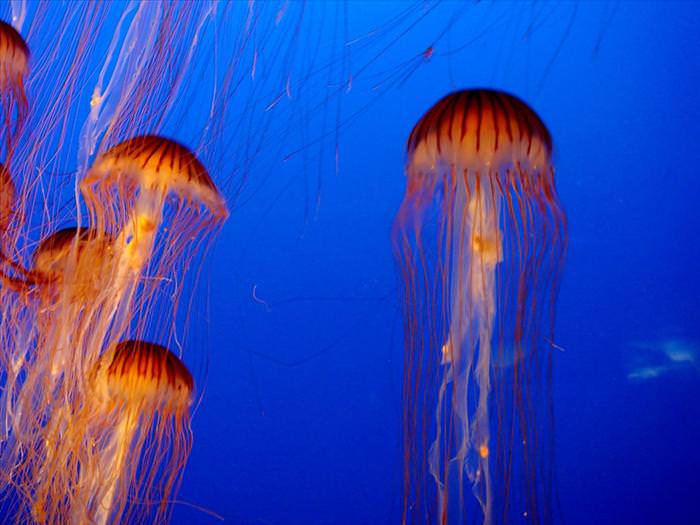 |
| On the left: A 'Pink Meanie' jellyfish (Drymonema larsoni), a species found in the Gulf of Mexico and the Caribbean actually feeds on smaller jellyfish known as 'moon jellies' (Aurelia). On the right: A newly discovered jellyfish 'Narcomedusae' with four main tentacles and a curious finding - another 4 secondary, smaller tentacles at the very edge of its body. When looking for food, this jellyfish holds its long tentacles in front in order to ambush its prey more effectively. |
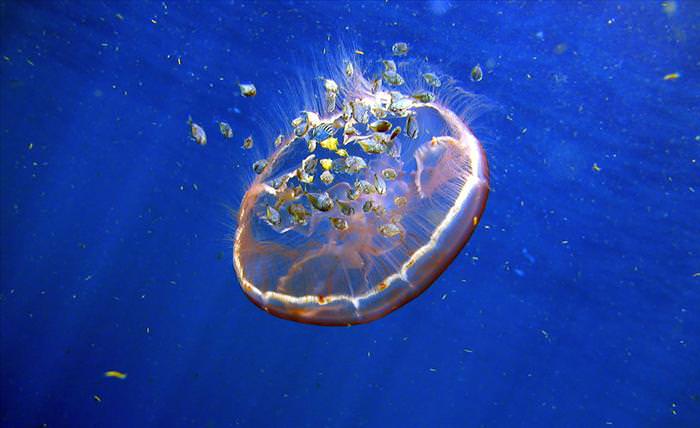 |
| Aurelia Aurita jellyfish seen during Operation Deep Scope, surrounded by a group of curious fish. |
 |
| Exploring the bottom of the ocean. |
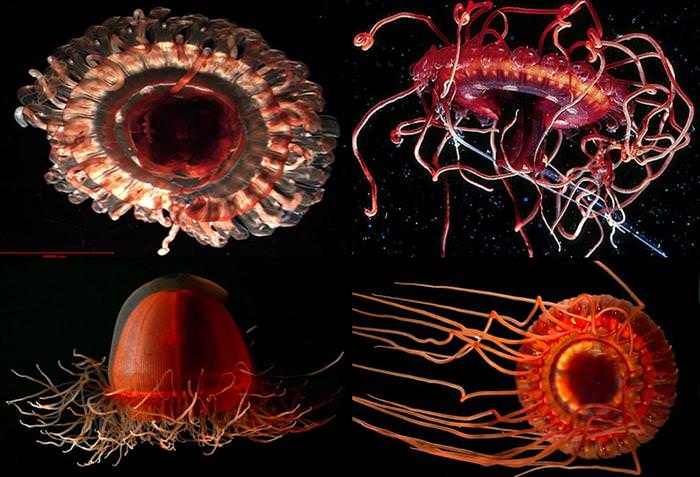 |
| Top left: Mid-water Sea Jelly: The mid-water Scyphomedusa Atolla Tenella, as seen under a microscope. Top right: Atolla is a jellyfish common from mid-water, about 500 meters deep, where there is still a small amount of sunlight, to depths of 4,500 meters, far below the limit of sunlight's penetration. Where there is light, its red color looks black, making it hard to see. It also produces brilliant bio-luminescence, possibly to frighten predators. Lower left: Alien-looking creatures, like this deep-red jellyfish, Crossota Norvegica, float in the Arctic Sea. Lower right: Operation Deep Scope NOAA: Eye-in-the-Sea Bioluminescence — The deep-sea Scyphozoan jellyfish, Atolla wyvillei, as seen under white light. |
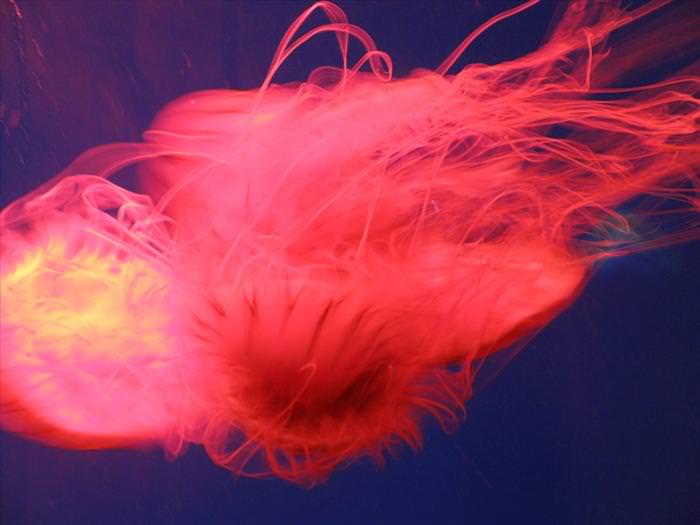 |
| A beautifully fluorescent jellyfish in an aquarium in Connecticut. |
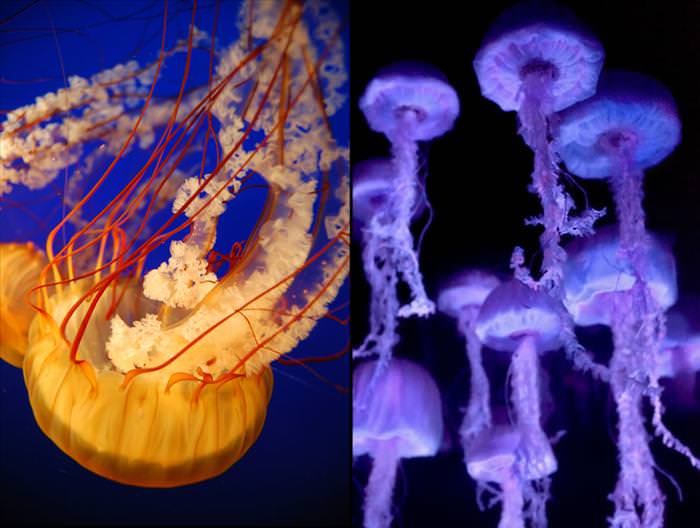 |
| A swarm of sea nettles (Chrysaora Fuscescens). |
 |
| A beautiful way to get stung. Be careful! |
 |
| Top: A sea nettle shot at the Monterrey Bay Aquarium in California. Bottom: A black sea nettle with four arms that can extend to several feet. Their sting usually comes with a burning sensation and their toxins are classified as moderate to severe. In other words, if you see these in the water, do NOT go in! This jelly is also a giant jelly, reaching 1 meter (3 feet) in size, while its tentacles can reach up to a whopping 6 meters (20 feet) in length! |
 |
| A 'Purple-Striped Jellyfish'. Shot at the Monterrey Bay Aquarium in California. This is the most known form of jellyfish and the shape most of us would recognize as the 'classic' jellyfish. |
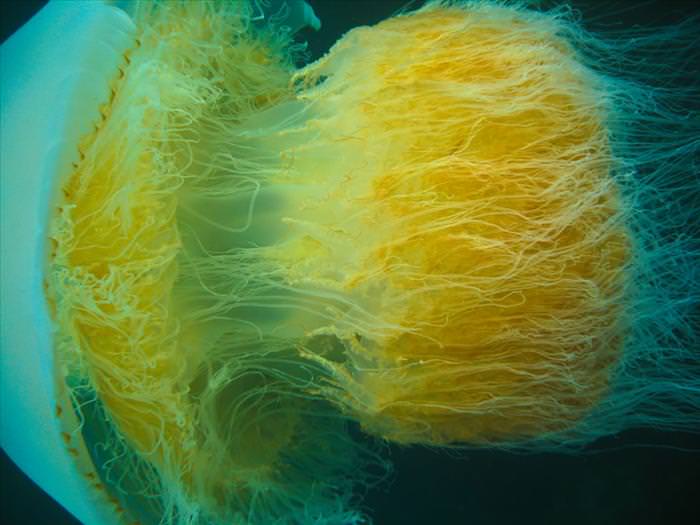 |
| The yellow Nomura Jelly shot in Little Munson Island in South Korea. |
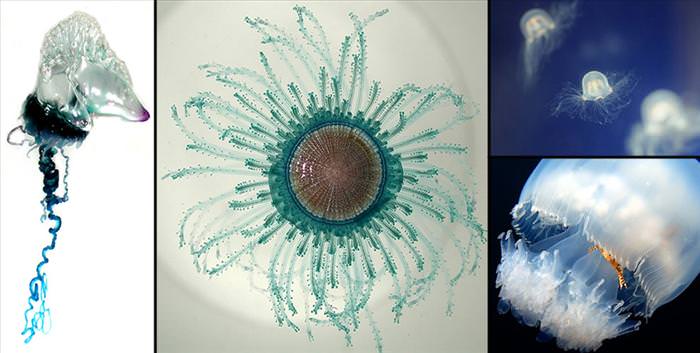 |
| On the left: A tiny but very dangerous Portuguese 'Man-O-War'. It may be small, but its sting has been compared to a COBRA's bite! This is in fact not a 'true jellyfish', but a collection of multiple tiny organisms. The tentacles, for example, are a different create than the gas bladder! Their tentacles can reach up to 45 meters! While this jelly can cause very painful stings and even, rarely, death, some animals (such as the clown fish) do not get hurt by its tentacles. Center: Porpita Porpita is a small, disc-shaped jelly that floats freely in the water, and is only one inch in diameter. Top-Right: Tiny jellies. Bottom-Right: The Bicol jellyfish. |
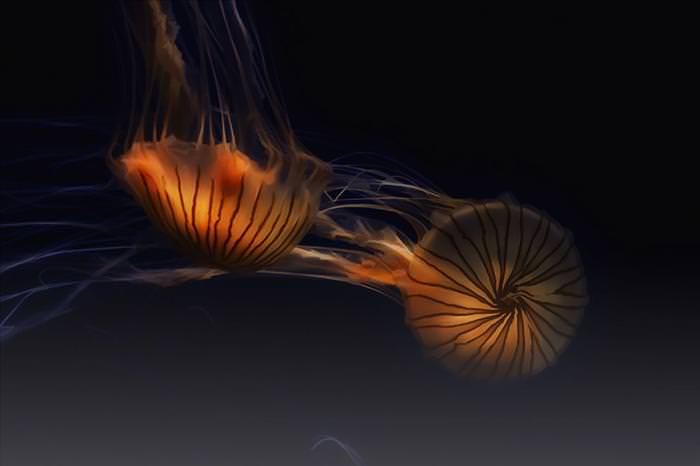 |
Most jellyfish live only 2-6 months, during which they can grow from one millimeter in size to many centimeters in diameter. In aquariums, tended andregularly fed, they can live up to several years. |
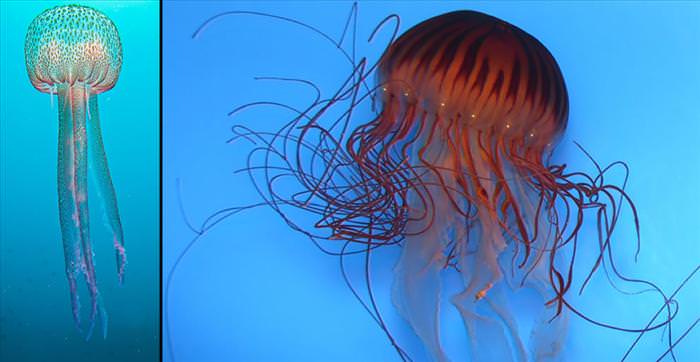 |
| On the left: Purple jellyfish shot in Spain. On the right: A jelly with 'alien spacecraft' lights on its body, shot at the Vancouver aquarium. |
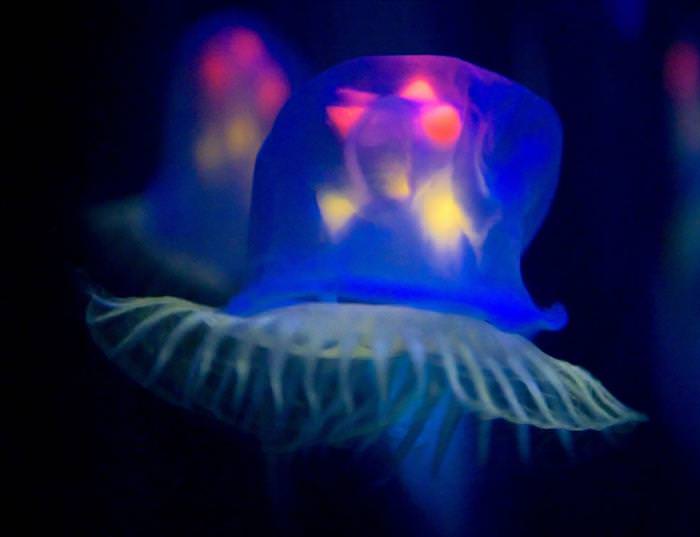 |
| Beautiful and colorful jelly shot in the Cnidaria aquarium zoo in Belgium. |
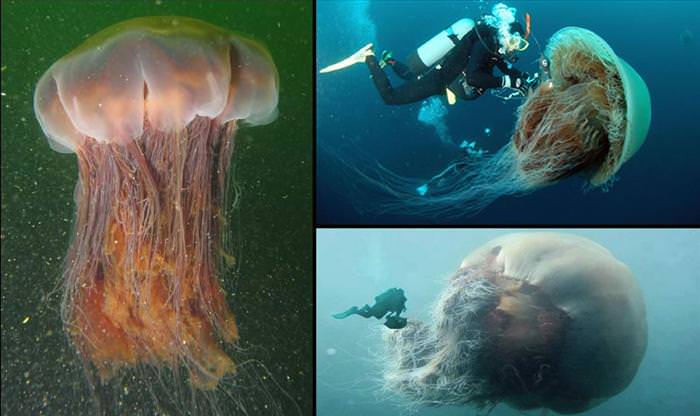 |
| On the left: The 'lion's mane' jellyfish, also known as the 'winter jelly' because the mane usually appears during the colder months of the year. They are found in the North Atlantic and can reach 2 meters (6 feet) in diameter with incredibly long tentacles that can reach up to 33 meters (100 feet) in length! They are considered moderate stingers and the pain they inflict is mild and often burns instead of stings. On the right: The Giant Nomura Jellyfish in Japan. This enormous, 450 pound and 7 feet long jelly has plagued Japanese waters and is about the size of a sumo wrestler. It still doesn't have the reach of the lion's mane tentacles though. |
 |
| A lion's mane jelly in Norway. |
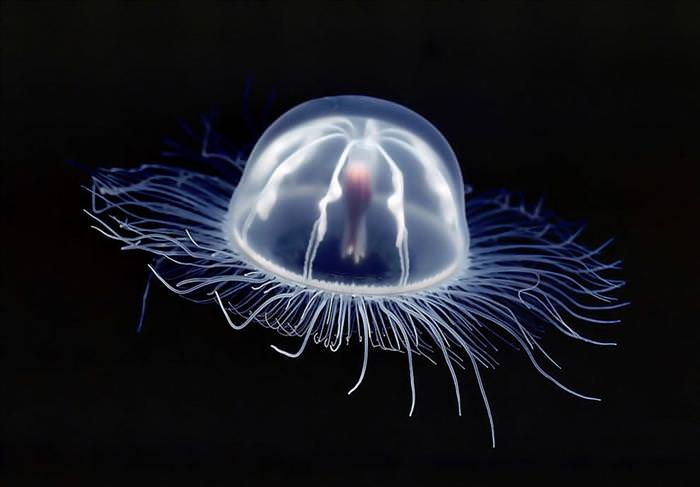 |
| A tiny, 2.5 cm long transparent jelly. Jellyfish reproduce both sexually (male and female) and asexually (without gender). Upon reaching their full size, they spawn according to available food and may even do so every day if there's enough of it. Their spawning is dependent on light, so they usually do it at the same time of day, at dusk or dawn. |
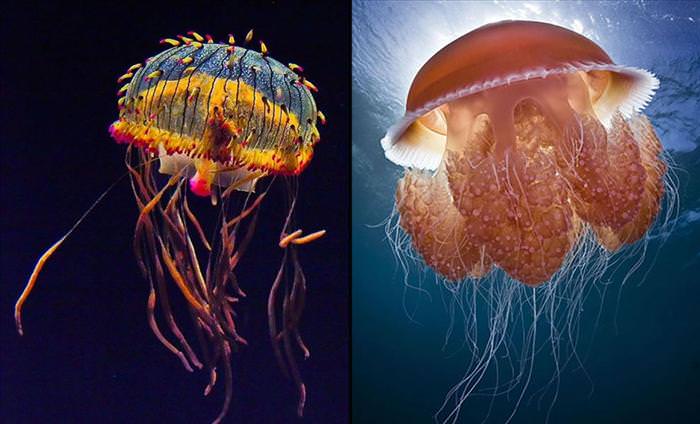 |
Left: This fancy looking jelly looks a bit like an expensive lamp. Right: A glowing jelly near the shores of Australia |
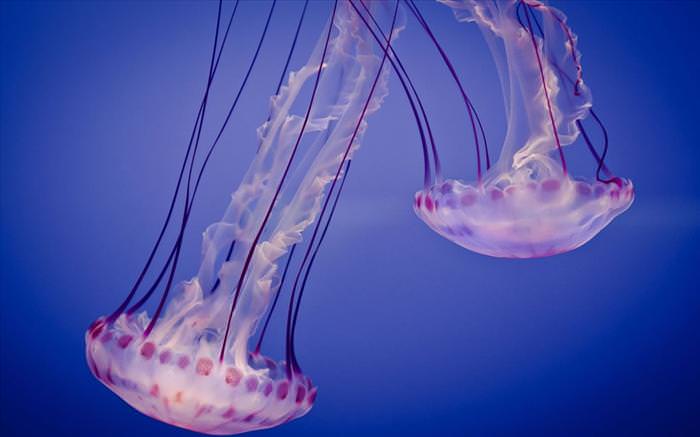 |
Jellyfish are made of up to 95% water (humans are about 55-65% water). Their soft, gelatin bodies have no skeletal frame or outer shell. They are therefore easily harmed and die if removed from water. However, even a dead jellyfish will sting you if you step on it. |
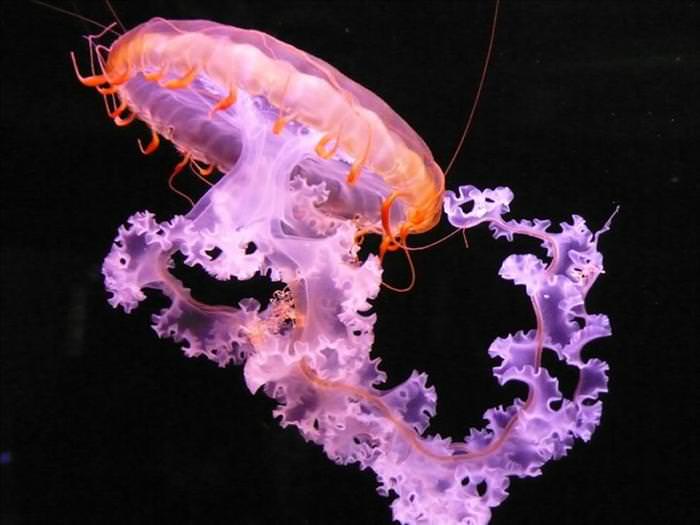 |
| This species of jellyfish may actually be IMMORTAL. The jelly can 'reverse' its life cycle, actually transforming from adult to immature organism. Wish we knew how to do that ourselves! |
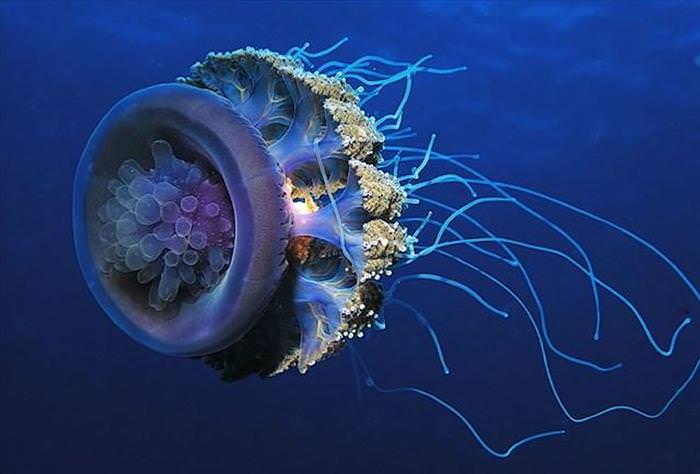 |
Since jellyfish aren't actually related to fish, the terms is a bit misleading |
Search Papers On This Blog. Just Write The Name Of The Course
Thursday 30 April 2015
))))Vu & Company(((( The Jellyfish: An Extraordinary Creatureسبحان الله
Subscribe to:
Post Comments (Atom)

No comments:
Post a Comment